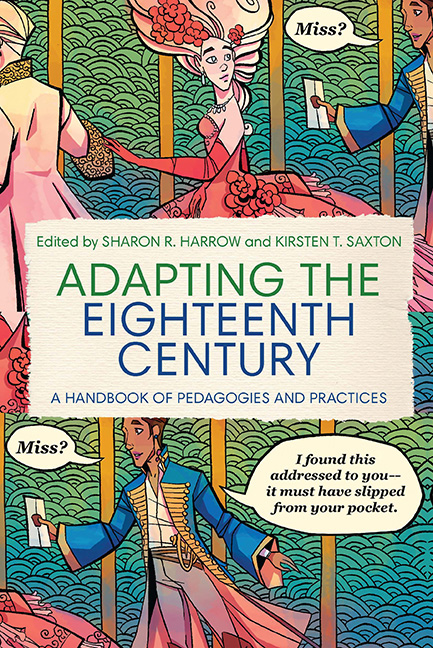Book contents
- Frontmatter
- Dedication
- Contents
- Acknowledgments
- Introduction
- 1 “Je suis Voltaire,” or, Appropriating the Philosophe in the Social Media Age
- 2 “Who Lives, Who Dies, Who Tells Your Story?”: The Uses of Hamilton in Special Collections Pedagogy and Public Engagement
- 3 Performing Frankenstein in the South: Sex, Race, and Science across the Disciplines
- 4 French Fairy Tales and Adaptations in the Twenty-First-Century Classroom
- 5 Select Trials at the Sessions-House in the Old-Bailey (1742) and Mark Ravenhill’s Mother Clap’s Molly House (2001)
- 6 Teaching with The Pilgrim’s Progress Video Game
- 7 Eliza Haywood’s “Bad Habits”: Teaching Adaptations of Fantomina: or, Love in a Maze and The Distress’d Orphan; or, Love in a Madhouse
- 8 Teaching Eighteenth-Century Literature through Eighteenth- Century Adaptations: Adaptive Structures
- 9 “A Private Had Been Flogged”: Adaptation and the “Invisible World” of Jane Austen
- 10 Fifty Shades of Pamela in the Undergraduate Classroom
- 11 Teaching the Austen-Monster-Mashup: Sense and Sensibility and Sea Monsters
- 12 Learning to Adapt: Teaching Pride and Prejudice and Its Adaptations in General Education Courses
- 13 Race and Romance: Adapting Free Women of Color in the Long Eighteenth Century
- 14 The Crusoeiana: Material Crusoe
- 15 Adaptation in Strange Places: Terrence Malick’s To the Wonder and the Narrative Effect and Form of Samuel Richardson’s Pamela
- 16 Adapting the Tombeaux des Princes: A Study in Media Variations
- 17 Experiential Pedagogy to Join the Thread of Conversation with Paul et Virginie
- 18 “Lookin’ for a Mind at Work”: Hamilton, Adaptation, and Enlightenment Ideals for the Core Curriculum
- Notes on the Contributors
- Index
3 - Performing Frankenstein in the South: Sex, Race, and Science across the Disciplines
Published online by Cambridge University Press: 26 April 2020
- Frontmatter
- Dedication
- Contents
- Acknowledgments
- Introduction
- 1 “Je suis Voltaire,” or, Appropriating the Philosophe in the Social Media Age
- 2 “Who Lives, Who Dies, Who Tells Your Story?”: The Uses of Hamilton in Special Collections Pedagogy and Public Engagement
- 3 Performing Frankenstein in the South: Sex, Race, and Science across the Disciplines
- 4 French Fairy Tales and Adaptations in the Twenty-First-Century Classroom
- 5 Select Trials at the Sessions-House in the Old-Bailey (1742) and Mark Ravenhill’s Mother Clap’s Molly House (2001)
- 6 Teaching with The Pilgrim’s Progress Video Game
- 7 Eliza Haywood’s “Bad Habits”: Teaching Adaptations of Fantomina: or, Love in a Maze and The Distress’d Orphan; or, Love in a Madhouse
- 8 Teaching Eighteenth-Century Literature through Eighteenth- Century Adaptations: Adaptive Structures
- 9 “A Private Had Been Flogged”: Adaptation and the “Invisible World” of Jane Austen
- 10 Fifty Shades of Pamela in the Undergraduate Classroom
- 11 Teaching the Austen-Monster-Mashup: Sense and Sensibility and Sea Monsters
- 12 Learning to Adapt: Teaching Pride and Prejudice and Its Adaptations in General Education Courses
- 13 Race and Romance: Adapting Free Women of Color in the Long Eighteenth Century
- 14 The Crusoeiana: Material Crusoe
- 15 Adaptation in Strange Places: Terrence Malick’s To the Wonder and the Narrative Effect and Form of Samuel Richardson’s Pamela
- 16 Adapting the Tombeaux des Princes: A Study in Media Variations
- 17 Experiential Pedagogy to Join the Thread of Conversation with Paul et Virginie
- 18 “Lookin’ for a Mind at Work”: Hamilton, Adaptation, and Enlightenment Ideals for the Core Curriculum
- Notes on the Contributors
- Index
Summary
The year 2016 marked the bicentennial of the initial composition of Mary Shelley's Frankenstein; or, The Modern Prometheus, and 2018 the bicentennial of its publication; for these two centuries, the interest in Frankenstein has never entirely left us. Shelley's novel and her creature have enjoyed a rich after- life in a multitude of forms; in print and on canvas, onstage and onscreen, authors, artists, playwrights, and filmmakers return time and time again to Shelley's tale of the collision between human nature and scientific outlook, and the potential hazards of unchecked scientific inquiry and its human and ethical consequences. The novel has been adapted since its inception; stu- dents are aware and engaged with the idea of the text—or the creature, if not the text itself—and they are familiar with performance-based adaptations of the novel. Consider only a few recent adaptations: Victor Frankenstein and his creature appeared as regulars on the Showtime series Penny Dreadful; Benedict Cumberbatch and Jonny Lee Miller brought the duo to life at the National Theatre in 2011; and in 2017, Victoria Frankenstein, MD took over YouTube as the first collaboration between Pemberley Digital and PBS Studios. I, Frankenstein (2014) attempted to extend the Underworld franchise by adding the creature (here named “Adam”), and Max Landis attempted to imitate the success of Guy Ritchie's Sherlock Holmes films, which trans- formed the Victorian detective into a steampunk-inspired action hero, by grafting this aesthetic on to Frankenstein's creature in Victor Frankenstein, a howlingly terrible film adaptation told from the perspective of Igor, played by Harry Potter star Daniel Radcliffe. The afterlife of the novel also inspired two Mary Shelley biopics: Elle Fanning in A Storm in the Stars (2017), and Sophie Turner in Mary Shelley's Monster (2016).
We brought this present popularity and the long, rich history of the nov- el's adaptation to our own multi-year project at Auburn University: adapting Frankenstein to make the long eighteenth century meaningful for students across our institution, a state university with particular strengths in engineer- ing and a current focus on notions of sustainability and climate change. We were especially inspired by the composition of Frankenstein during 1816's famous “year without a summer.”
- Type
- Chapter
- Information
- Adapting the Eighteenth CenturyA Handbook of Pedagogies and Practices, pp. 47 - 70Publisher: Boydell & BrewerPrint publication year: 2020



